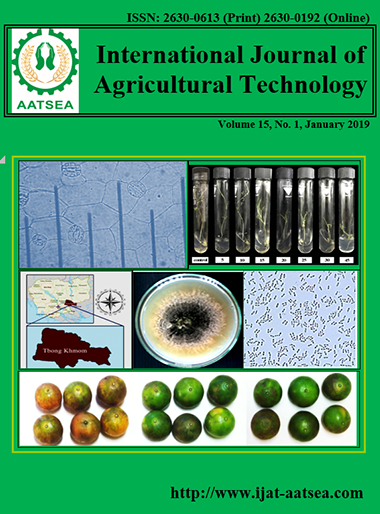The study of rubber tapping technology quality in Memot Rubber Plantation Co., Ltd.
Main Article Content
Abstract
The quality of rubber tapping technology was assessed at Memot Rubber Plantation Co., Ltd, located in Memot District, which is located on the east of the provincial capital of Tboung Khmum province, Cambodia. The research finding was conducted from March 20 to June 20, 2018 with 140 of rubber tappers and inspected 140 tapping tasks of tapping plots (6 tr/task ration with the length cut S/2 d3 7d/7 of the clones RRIM600 and GT1, 2008). The grading quality of rubber tapping technology was recorded. The factors with tapping technology quality and rubber bark consumption was determined the variable evidence and analyzed the relationship between eight factors with grade of rubber tapping technology quality. The results showed that 140 rubber tappers the assessed rubber tapping technology quality as following of a very good, good, fairly good, fairly, and poor grade approximately 13%, 4%, 18%, 22%, and 43%, respectively. Most of rubber tapping quality were in poor grade level such as 12.7A, 12.7B, 12.7C, 12.7D, 12.6B, 12.6C, 11.6C, 14.7B, 14.7C, 14.7D, 14.6C approximately 73.68%, 74.22%, 72.64%, 72.11%, 71.40, 72.23%, 71.27%, 71.82%, 74.55%, 72.60%, 65.30%, respectively. There were only two plots in fairly grade level such as 11.6B, 15.7C approximately 76.82%, 75.09%, respectively. Amongst of eight factors, there was X8 bark consumption had relationship with rubber tapping technology quality (Y) (P<0.05) and all of eight factors showed that (X4) horning of tapping knives, (X7) training, (X8) tapping quality had relationship with rubber bark consumption (Y) (P<0.05).
Article Details

This work is licensed under a Creative Commons Attribution-NonCommercial-NoDerivatives 4.0 International License.
References
Alcala, T. B., Taponsok, L. A., Testado, A. M. and Testedo, R. A. (2005). Assessment of the status, problems and constraint of the Philippine rubber smallholders. Proceeding of the national rubber conference, Philippines.
Aun, S., Touch, V., San, V. and Chhun, T. (2010). Rubber Farmers’ Perception of Rubber Technologies in Dambae and Peam Cheang, Kampong Cham. International Journal of Environmental and Rural Development. 1-1:25-30.
FAO (2014). Socio-economic Context and Role of Agriculture. Country Fact Sheet on Food and Agriculture Policy Trends. pp. 1-6.
Hav, S., Eric, G., Chhek, C., Mak, S. and Regis, L. (2016). Yield Potential of Clone IRCA 230 in Cambodia. CRRI&IRRDB International Rubber Conference 2016, Siem Reap, Cambodia. pp. 269-280.
Ministry of agriculture, Forestry and Fishery, Cambodia (2001). Rubber tapping control. office of rubber technology.
OECD (2013). Structural Policy Country Notes Cambodia. Structural Policy country notes for emerging asia. Retrieved from https://www.oecd.org/site/seao/cambodia.pdf.
Phean, C., Phen, P., Hak, B., Regis, L., Chhek, C., Mak, S. and Eric, G. (2016). Yield Performance of 8 Rubber Clones after 14 years of Tapping in Cambodia. CRRI & IRRDB International Rubber Conference 2016, Siem Reap, Cambodia. pp. 281-285.
Phen, P., Phean, C., Hak, B., Regis, L., Mak, S., Eric, G. and Chhek, C. (2016). Early Clonal Selection of Hevea Brasiliensis Based on Latex Physiological Parameters in Cambodia. CRRI&IRRDB International Rubber Conference 2016, Siem Reap, Cambodia. pp. 286-297.
Pramoolkit, P., Lertpanyasampatha, M., Viboonjun, U., Kongsawadworakul, P., Chrestin, H. and Narangajavana, J. (2014). Involvement of ethlene-responsiv microRNAs and their targets in increased latex yield in the rubber tree in response to ethylene treatment. Plant Physiology and Biochemistry. 84:203-212.
Priyadarshan, P. M., Hoa, T. T. T., Huasun, H. and Goncalves, P. d. S. (2005). Yielding potential of rubber (Hevea brasiliensis) in sub-optimal environments. The Haworth Press Inc.: Philadelphia. pp. 221-247.
Puskas, J. E., Chiang, k. and Barkakaty, B. (2014). Natural rubber (NR) biosynthesis: perspectives from polymer chemistry. Universtiy of Akron, USA. 2:30-67. https://doi.org/10.1533/9780857096913.1.30.
Shigematsu, A., Mizoue, N., Ide, K., Khun, K., Pheng, M., Yoshida, Kohroki, K. and Sato, N. (2011). Estimation of Rubberwood Production in Cambodia. New Forests. 42:149-162.
Somboonsuke, B. (2009a). Dynamic of Thai Rubber Smallhollings Sector. In Agriculture System of Para Rubber Smallholding Sector in Thailand. Prince of Songkla University, Thailand. pp. 89-123.
Somboonsuke, B. (2009b). Technology and Innovation of Rubber Smallholding Sector. In Agriculture System of Para Rubber Smallholding Sector in Thailand. Prince of Songkla University, Thailand. pp. 124-176.
Somboonsuke, B. (2009c). Thai Natural Para Rubber and Rubber Smallholding Sector. In Agriculture System of Para Rubber Smallholding Sector in Thailand. Prince of Songkla University, Thailand. pp. 31-88.
Somboonsuke, B, Pacheerat, K. and Wettayaprasit, P. (2009). A Socio-economic Simulation of Rubber Smallholding Systems: A Case Study of Phatthalung and Songkhla Provinces in Southern Thailand. Chiang Mai University Journal of Social Sciences and Humanities. 3:113-134.


